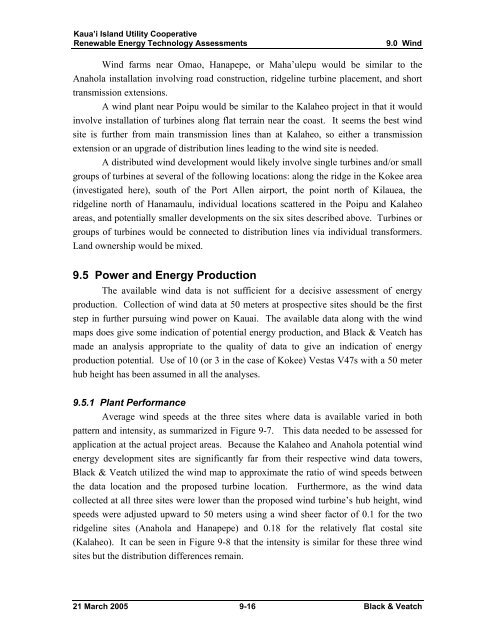Renewable Energy Technology Assessments - Kauai Island Utility ...
Renewable Energy Technology Assessments - Kauai Island Utility ...
Renewable Energy Technology Assessments - Kauai Island Utility ...
You also want an ePaper? Increase the reach of your titles
YUMPU automatically turns print PDFs into web optimized ePapers that Google loves.
Kaua’i <strong>Island</strong> <strong>Utility</strong> Cooperative<br />
<strong>Renewable</strong> <strong>Energy</strong> <strong>Technology</strong> <strong>Assessments</strong> 9.0 Wind<br />
Wind farms near Omao, Hanapepe, or Maha’ulepu would be similar to the<br />
Anahola installation involving road construction, ridgeline turbine placement, and short<br />
transmission extensions.<br />
A wind plant near Poipu would be similar to the Kalaheo project in that it would<br />
involve installation of turbines along flat terrain near the coast. It seems the best wind<br />
site is further from main transmission lines than at Kalaheo, so either a transmission<br />
extension or an upgrade of distribution lines leading to the wind site is needed.<br />
A distributed wind development would likely involve single turbines and/or small<br />
groups of turbines at several of the following locations: along the ridge in the Kokee area<br />
(investigated here), south of the Port Allen airport, the point north of Kilauea, the<br />
ridgeline north of Hanamaulu, individual locations scattered in the Poipu and Kalaheo<br />
areas, and potentially smaller developments on the six sites described above. Turbines or<br />
groups of turbines would be connected to distribution lines via individual transformers.<br />
Land ownership would be mixed.<br />
9.5 Power and <strong>Energy</strong> Production<br />
The available wind data is not sufficient for a decisive assessment of energy<br />
production. Collection of wind data at 50 meters at prospective sites should be the first<br />
step in further pursuing wind power on <strong>Kauai</strong>. The available data along with the wind<br />
maps does give some indication of potential energy production, and Black & Veatch has<br />
made an analysis appropriate to the quality of data to give an indication of energy<br />
production potential. Use of 10 (or 3 in the case of Kokee) Vestas V47s with a 50 meter<br />
hub height has been assumed in all the analyses.<br />
9.5.1 Plant Performance<br />
Average wind speeds at the three sites where data is available varied in both<br />
pattern and intensity, as summarized in Figure 9-7. This data needed to be assessed for<br />
application at the actual project areas. Because the Kalaheo and Anahola potential wind<br />
energy development sites are significantly far from their respective wind data towers,<br />
Black & Veatch utilized the wind map to approximate the ratio of wind speeds between<br />
the data location and the proposed turbine location. Furthermore, as the wind data<br />
collected at all three sites were lower than the proposed wind turbine’s hub height, wind<br />
speeds were adjusted upward to 50 meters using a wind sheer factor of 0.1 for the two<br />
ridgeline sites (Anahola and Hanapepe) and 0.18 for the relatively flat costal site<br />
(Kalaheo). It can be seen in Figure 9-8 that the intensity is similar for these three wind<br />
sites but the distribution differences remain.<br />
21 March 2005 9-16 Black & Veatch
















